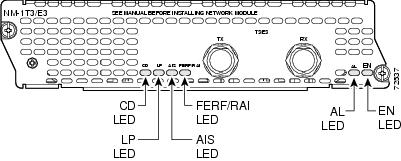T3 and E3 Network Modules
Available Languages
Table Of Contents
Connecting Cisco T3 and E3 Network Modules to the Network
Connecting T3/E3 Network Modules to the Network
Obtaining Documentation, Obtaining Support, and Security Guidelines
Connecting Cisco T3 and E3 Network Modules to the Network
Revised: May 1, 2008, OL-12824-01
This guide describes how to connect Cisco T3 and E3 network modules to your network. It contains the following sections:
•
Connecting T3/E3 Network Modules to the Network
•
Obtaining Documentation, Obtaining Support, and Security Guidelines
1-Port T3/E3 Network Modules
The NM-1T3/E3 network module is a single-port universal T3/E3 network module with integrated CSU/DSU, clear channel, and subrate support. (See Figure 1.) Channels on the network module can be configured as either T3 or E3 through Cisco IOS software.
Figure 1 1-Port T3/E3 Network Module Faceplate


Note
The NM-1T3/E3 network module provides subrate T3 support for Digital Link, Kentrox, Larscom, Verilink, and Adtran. The NM-1T3/E3 network module also provides subrate E3 support for Digital Link and Kentrox.
Connecting T3/E3 Network Modules to the Network
To connect a T3/E3 network module to the network, use a 75-ohm 728-A coaxial cable to connect the BNC connector on the network module to a networking device. (See Figure 2.)

Warning
This equipment contains a ring signal generator (ringer), which is a source of hazardous voltage. Do not touch the RJ-11 (phone) port wires (conductors), the conductors of a cable connected to the RJ-11 port, or the associated circuit-board when the ringer is active. The ringer is activated by an incoming call. Statement 1042

Warning
If the symbol of suitability with an overlaid cross appears above a port, you must not connect the port to a public network that follows the European Union standards. Connecting the port to this type of public network can cause severe injury or damage your router. Statement 1031

CautionThe intra-building port(s) of the NM-1T3/E3 is suitable for connection to intrabuilding or unexposed wiring or cabling only. The intrabuilding port(s) of NM-1T3/E3 MUST NOT be metallically connected to interfaces which connect to the OSP or its wiring. These interfaces are designed for use as intra-building interfaces only (Type 2 or Type 4 ports as described in GR-1089-CORE, Issue 4) and require isolation from the exposed OSP cabling. The addition of Primary Protectors is not sufficient protection in order to connect these interfaces metallically to OSP wiring.

CautionTo minimize transient surges, the internal wiring should not be routed in the same conduit with power lines or external telephone lines.
Figure 2 Connecting a T3/E3 Network Module to a Networking Device (Cisco 7603 Router Shown)


Tip
When connecting the T3/E3 network module to a port adapter used in another router series, verify that you are connecting the TX port on the network module with the RX port on the port adapter, and the TX port on the port adapter to the RX port on the network module.
T3/E3 Network Module LEDs
All network modules have an enable (EN) LED. This LED indicates that the module has passed its self-tests and is available to the router. See Figure 3 and Table 1 for LEDs on the T3/E3 network module.
Figure 3 T3/E3 LEDs

Related Documents
For additional information, see the following documents and resources.
Cisco T3/E3 network module software configuration
Clear Channel T3/E3 with Integrated CSU/DSU
http://www.cisco.com/en/US/docs/ios/12_2t/12_2t15/feature/guide/ft_te3nm.html
Regulatory compliance and safety information
Cisco Network Modules and Interface Cards Regulatory Compliance and Safety Information
http://www.cisco.com/en/US/docs/routers/access/interfaces/rcsi/IOHrcsi.htmlCisco IOS software website and reference documentation
Cisco IOS Software http://www.cisco.com/web/psa/products/index.html?c=268438303
Obtaining Documentation, Obtaining Support, and Security Guidelines
For information on obtaining documentation, obtaining support, providing documentation feedback, security guidelines, and also recommended aliases and general Cisco documents, see the monthly What's New in Cisco Product Documentation, which also lists all new and revised Cisco technical documentation, at:
http://www.cisco.com/en/US/docs/general/whatsnew/whatsnew.html
CCDE, CCENT, Cisco Eos, Cisco Lumin, Cisco Nexus, Cisco StadiumVision, Cisco TelePresence, the Cisco logo, DCE, and Welcome to the Human Network are trademarks; Changing the Way We Work, Live, Play, and Learn and Cisco Store are service marks; and Access Registrar, Aironet, AsyncOS, Bringing the Meeting To You, Catalyst, CCDA, CCDP, CCIE, CCIP, CCNA, CCNP, CCSP, CCVP, Cisco, the Cisco Certified Internetwork Expert logo, Cisco IOS, Cisco Press, Cisco Systems, Cisco Systems Capital, the Cisco Systems logo, Cisco Unity, Collaboration Without Limitation, EtherFast, EtherSwitch, Event Center, Fast Step, Follow Me Browsing, FormShare, GigaDrive, HomeLink, Internet Quotient, IOS, iPhone, iQ Expertise, the iQ logo, iQ Net Readiness Scorecard, iQuick Study, IronPort, the IronPort logo, LightStream, Linksys, MediaTone, MeetingPlace, MeetingPlace Chime Sound, MGX, Networkers, Networking Academy, Network Registrar, PCNow, PIX, PowerPanels, ProConnect, ScriptShare, SenderBase, SMARTnet, Spectrum Expert, StackWise, The Fastest Way to Increase Your Internet Quotient, TransPath, WebEx, and the WebEx logo are registered trademarks of Cisco Systems, Inc. and/or its affiliates in the United States and certain other countries.
All other trademarks mentioned in this document or Website are the property of their respective owners. The use of the word partner does not imply a partnership relationship between Cisco and any other company. (0807R)
Any Internet Protocol (IP) addresses used in this document are not intended to be actual addresses. Any examples, command display output, and figures included in the document are shown for illustrative purposes only. Any use of actual IP addresses in illustrative content is unintentional and coincidental.
© 2008 Cisco Systems, Inc. All rights reserved.
Contact Cisco
- Open a Support Case

- (Requires a Cisco Service Contract)
 Feedback
Feedback